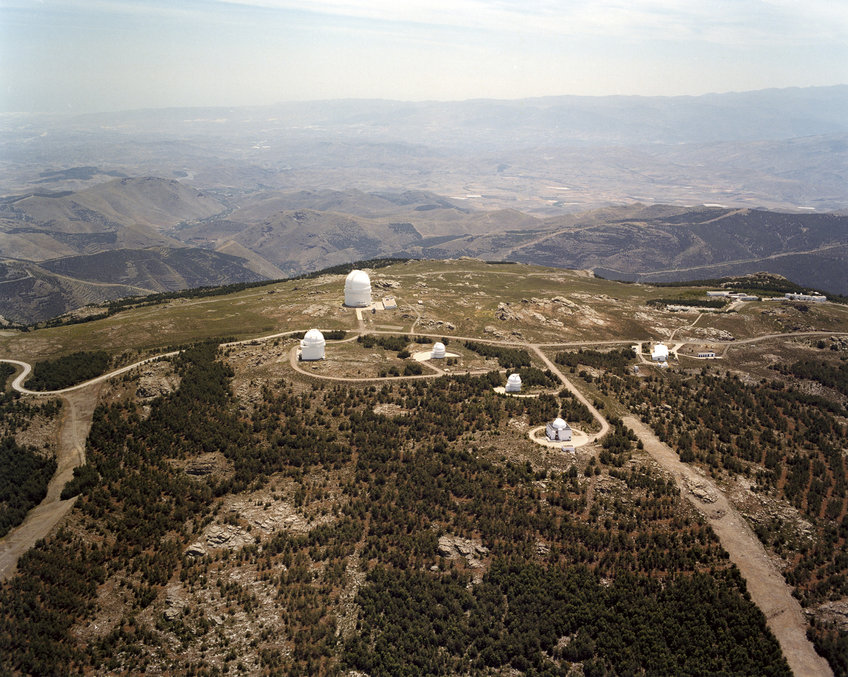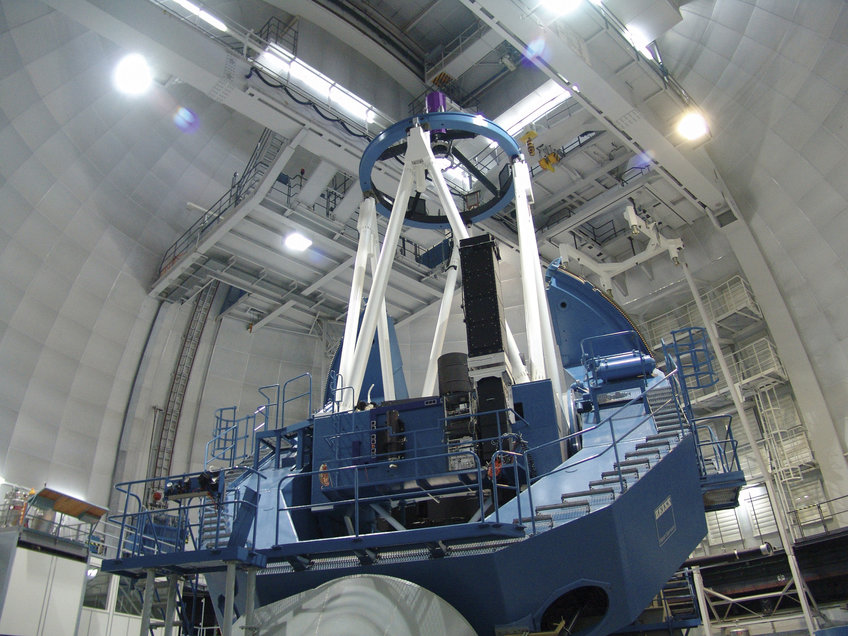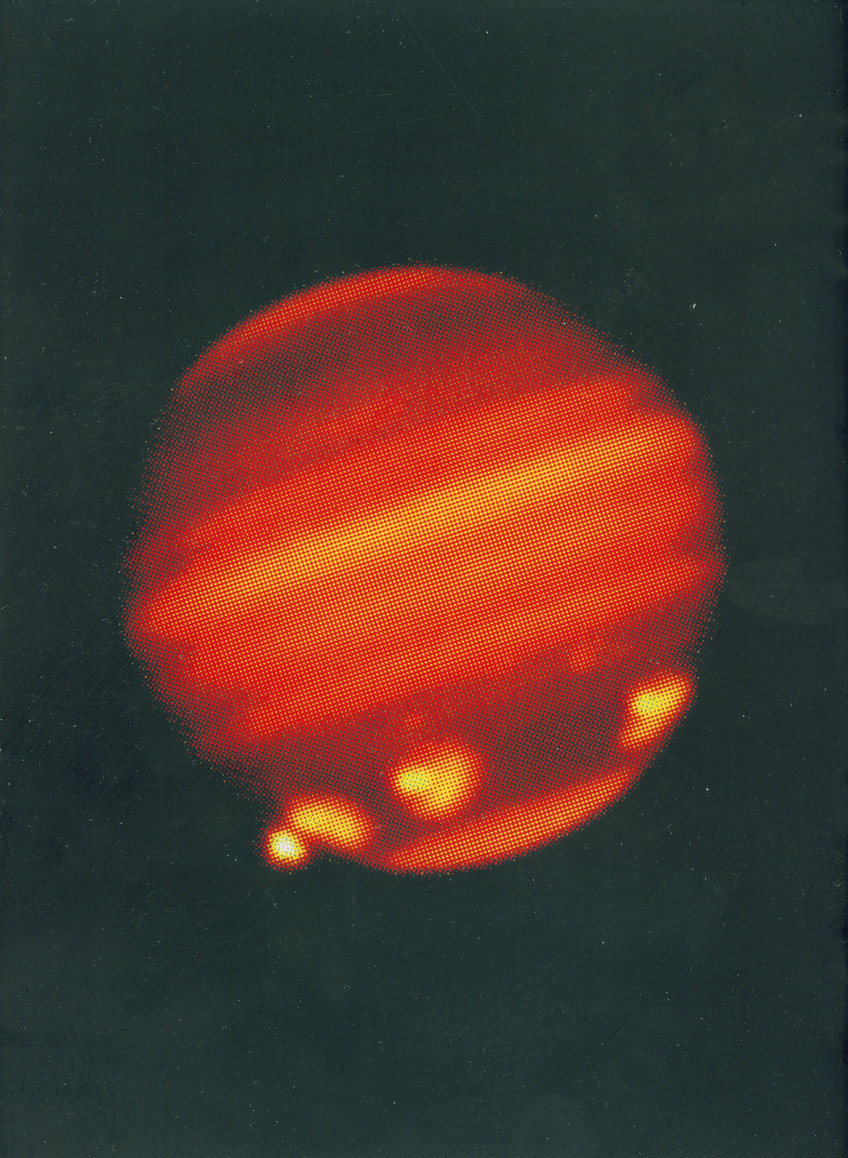25 Years of Calar Alto Observatory
From the Past to the Future
The former branch of the Heidelberg Max Planck Institute for Astronomy, the largest observatory on the European mainland, is looking back on eventful times and into a new future.
On September 28th, 1979, the German-Spanish Astronomical Center or Centro Astronomico Hispano-Aleman in Andalusia (CAHA or Calar Alto Observatory for short) was officially inaugurated by King Juan Carlos I of Spain. Thus for the first time an observatory - situated on the Calar Alto Mountain (altitude 2168 m) in the Sierra de los Filabres - was available to German astronomers and their Spanish colleagues that enabled them to catch up with international astronomical standards after World Wars I and II. Since then, four telescopes of different sizes as well as state-of-the-art cameras and spectrographs are working there at the very frontiers of research. With their help, a number of outstanding discoveries were made in the past, and in the future, too, the Calar Alto Observatory will continue to play a major role.
In November, an agreement was signed by the Spanish Consejo Superior de Investigaciones Científicas and the German Max Planck Society which provides a common operation of CAHAfor the next ten years as an organization under Spanish law.
Starting at Zero
After World War II, observational astronomy in Germany was in a desolate condition. Observing programs on an international level were practically impossible as the largest telescope in the Federal Republic of Germany then was the 1-m reflector in Hamburg-Bergedorf dating from 1910, followed by the 72-cm reflector of the Landessternwarte Heidelberg on the Königstuhl, built in 1906.
In this situation, the memorandum On the Status of Astronomy issued in 1962 on behalf of the German Research Association (Deutsche Forschungsgemeinschaft, DFG) brought about the decisive turn of events. In this memorandum German astronomers complained: "The lack of suitable instruments has enormously hampered our work on the large-scale structure of the Galaxy and excluded our country for decades from the empirical investigation of extragalactic objects". In other words: the telescopes available did not have enough light-gathering power to be used for the study of distant galaxies. In order to remedy this defect the astronomers particularly recommended in the memorandum (in addition to other measures) "the establishment of national institutions of supra-regional character, such as an optical observatory in a favorable climate with larger instruments".
Significant contributions to this memorandum were made by Hans Elsässer, the future founding director of the Max Planck Institute for Astronomy in Heidelberg. At the 1969 meeting of the Astronomische Gesellschaft in Mannheim he emphasized that "these plans [for establishing an efficient German observatory] were conceived under the impression that the future demand for modern observing institutions will not sufficiently be met by the European Southern Observatory (ESO) and that on the other hand a German participation in such international institutions will only be of advantage if an adequate development of the national institutions is ensured."
So when the Senate of the Max Planck Society decided in 1967 to establish a new Max Planck Institute for Astronomy (MPIA) in Heidelberg the prerequisites were also created for the establishment of this observatory which would be a branch of MPIA. The original goal was to set up two observatories, one in the Mediterranian area and a counterpart on the southern hemisphere. Both observatories were supposed to get a 2.2-m reflector while one would additionally be equipped with a 3.5-m telescope. Moreover, a 1.2-m telescope as well as the large Schmidt-reflector of the Hamburg observatory were planned to be installed at the Mediterranian station.
As early as 1969, the Jena glass company Schott, Mainz, was ordered to deliver the mirror blanks made of a then barely tested glass-ceramics material called Zerodur, while an order for the construction of the first of the two 2.2-m telescopes was placed with the C. Zeiss company, Oberkochen. Early in 1970, a decision was taken in favor of the Calar Alto (2168 m high) in the province of Almería as the site of the Mediterranian area observatory. In a contract negotiated between the governments of the German Federal Republic and Spain the new observatory was defined as a common project of both countries, under the responsibility of the Max Planck Society and the Comisión Nacionale de Astronomía.
In September 1970, the decision about the second site on the southern hemisphere was also taken. Expeditions to the south of Africa had shown the Gamsberg (2320 m high), situated 120 km to the southwest of Windhoek, Namibia, to offer particularly favorable climatic conditions. However, already in the following year first difficulties emerged. The German Federal Government, with regard to UN resolutions concerning Namibia, expressed its doubts about the establishment of a telescope on the Gamsberg mountain: This would have meant recognition and support of the South African regime which was de facto ruling there. That was the end of the project of a German Southern Observatory. The 3.5-m telescope was placed on Calar Alto and the 2.2-m telescope intended for South-West Africa was installed in Chile at the site of the European Southern Observatory (ESO) on la Silla as a guest instrument of the Max Planck Society.
In Spain, too, astronomical research was in a non-favorable situation in the early 1970s. There were only a few permanent positions available and no access to modern observing instruments. The opportunity of establishing an observatory together with the Max Planck Society on the Calar Alto in the province of Almería meant a new start for the development of this research field. So an additional, purely Spanish, 1.52-m telescope was erected on Calar Alto that is operated independently of CAHA.
The Calar Alto Observatory was put into operation in several stages. The first telescope to work from mid-1975 on was the 1.2-m telescope funded by the German Research Association. After the commissioning of the 2.2-m telescope and its two spectrographs in summer 1979 the ceremonial inauguration of the Calar Alto Observatory could take place in the presence of the Spanish royal couple.
The next telescope shipped to the mountain was the redesigned Hamburg Schmidt-reflector. Finally, in 1985, the 3.5-m telescope was tested and then made available to guest observers from July 1986 on. In 1988, the establishment of the Calar Alto Observatory was considered completed.

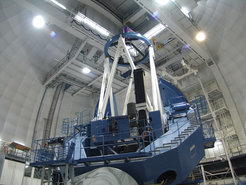
Thus German astronomers for the first time got the opportunity to carry out their research on international standards at an observatory of their own (some scientific highlights will be described below). The rising Spanish astronomical research, too, received an enormous impetus by the establishment of CAHA, which together with other astronomical institutions on Spanish ground has given Spain over the years a prominent position within international astronomy. Systematic measurements of the seeing and the brightness of the sky background have shown that the conditions at the Calar Alto Observatory are of comparable good quality as those at famous observatories in the USA. In the recent past about one hundred scientific papers based on observations made on Calar Alto have been published per year. And there is still an unbroken demand for observing time. For the 3.5-m telescope, e.g., about three times as much observing time is requested for as can be allocated.
Scientific Instrumentation
A large telescope will become a powerful discovery machine only in combination with an efficient instrument. Therefore astronomers and engineers at the Heidelberg home institute as well as at other institutes are continuously developing and building new instruments to be operated on Calar Alto. For the 2.2- and 3.5-m telescopes alone 13 instruments are currently available. Occasionally, guest scientists are bringing their own instruments for conducting their observations.
Especially in recent years MPIA has built a number of cameras and spectrographs that are undoubtedly the world's top instruments of their kind. Since last year, for instance, a near-infrared camera called Omega 2000 is working at the 3.5-m telescope. Its most remarkable feature is its large field of view of 15 arc minutes times 15 arc minutes, corresponding to a quarter of the size of the full moon. This makes Omega 2000 a unique instrument because large infrared detectors with 2048 times 2048 pixels (4 Megapixels) are available only since recently. Such a detector allows this large field of view to be achieved in the prime focus of the 3.5-m telescope (with a focal ratio of f /2.35).
Wide field cameras for the infrared regime are currently much sought after by astronomers. They are mainly used to search large areas of the sky for galaxies that are many billions light years away. Since the moment when these distant objects emitted the light we are receiving today the universe continued to expand. And as a result the wavelength of the emitted light has also been stretched. Light that started its long journey as UV light in the distant past has been shifted into the infrared region when it reaches us today. In addition, these cameras are also ideal searching machines for brown dwarfs and protoplanetary disks.
However, cameras with a large field of view are also needed for the optical spectral range – for imaging extended stellar or galaxy clusters, for instance. Here the new LAICA camera is a top-class instrument. With its 4096 times 4096 pixel (16.8 Megapixel) CCD detector it can image an area of the sky as large as the full moon.
In addition to these cameras there are also spectrographs available. Instruments such as Twin and OmegaCass, both used at the 3.5-m telescope, do not produce striking images but split the light of celestial bodies into its spectral colors. Instruments of that kind enable astronomers to measure significant quantities like distances and velocities of celestial bodies or their chemical compositions, densities and temperatures. Spectrographs make out the physical warrants of apprehensions for stars and galaxies, so to speak.
Astronomers and engineers at MPIA have performed technological pioneering work in developing and building a so-called adaptive optics system. Such an instruments allows to compensate the "flickering" of stars during an astronomical exposure which would smear out the image. In this way, the theoretically possible resolution of the telescope can be achieved.
Astronomers and engineers at MPIA, together with colleagues from the MPI for Extraterrestrial Physics in Garching, have built an adaptive optics system for the near-infrared spectral range (ALFA) for the Calar Alto Observatory. It has been routinely operated there since several years. This system additionally contains a novelty: an artificial "laser guide star" . Adaptive optics only works if the field of view contains a star of sufficient brightness. By means of this reference star a so-called wavefront sensor measures the actual atmospheric turbulences and using this information continuously corrects the exposure. If there is no natural bright star within the image field an artificial one is created. For this a laser beam is pointed parallel to the telescope's optical axis towards the sky. At an altitude of about 90 kilometers, the laser beam excites atmospheric sodium atoms, which then start glowing. The spot of light created in this way serves as a reference star for the adaptive optics.
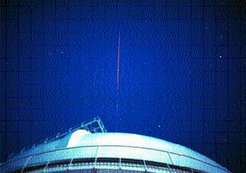
The experience gained with this instrument will soon be utilized at the ESO Very Large Telescope in Chile and at the Large Binocular Telescope (LBT) on Mount Graham, Arizona. German institutes, under the leadership of MPIA, are participating in the LBT by 25 percent.
Scientific Highlights
In the early years of the Calar Alto Observatory stars and nebulae within our Milky Way system had been the focus of research. Only when the 2.2-m telescope was put into operation astronomers at MPIA had a telescope at their disposal that was powerful enough to study even distant faint galaxies. A first main research field was star formation . A pioneering work on this subject was published in 1978 when Hans Elsässer, director of MPIA, found out that gas and dust surrounding most young stars are often arranged in a disk around the young central star. This confirmed an essential prediction of star formation theory: According to it stars are forming in the interior of dense collapsing dust clouds. Centrifugal forces pull the rotating cloud apart and flatten it to form a disk. While the matter at the center is condensing into a star planets are forming within the disk, as it was established for the first time in the 1990s.
Early in the 1980s, this field of research experienced another climax when astronomers at MPIA discovered strongly confined gas jets to emerge from young stars, shooting out into space at several hundred kilometers per second. These jets are perpendicular to the circumstellar dust disk and can span several light years. This finding came as a surprise since until then it was believed that young stars would only accrete matter from the surrounding disk, growing in this way. Now it was shown for the first time that in this process they also are ejecting gas into space. The influence of jets on the evolution of young stars and maybe on the newly forming planets is still a subject of research.
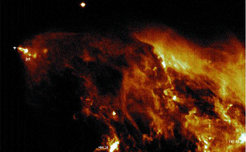
When the 2.2-m telescope was put into operation on Calar Alto in 1979 astronomers finally also got access to the realm of distant galaxies. A major discovery was made in the mid-1980s. At that time astronomers at MPIA observed objects which were visible only as faint blurry spots on the images taken until then. Detailed studies now showed that they were so-called interacting galaxies - stellar systems experiencing either close encounters during which they are gravitationally interacting or even collisions. During such cosmic (near-) collisions dust and gas in the interiors of the galaxies are heavily whirled around, which may trigger violent bursts of star formation. Today this field of research is still relevant, also because it is widely assumed that giant elliptical galaxies have formed by mergers of spiral galaxies.
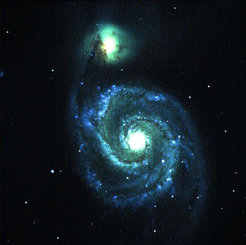
Another research focus at MPIA is the phenomenon of extragalactic jets . For many years astronomers are observing radio galaxies and quasars that show one or two (oppositely directed) gas jets shooting out from their central region. These jets can extend up to several million light years into space before they are ending up in huge radio lobes. Up to now several hundred jets are known in the radio range, but only three of them are sufficiently extended and bright enough to be studied spatially resolved in visible light. Among them is the jet of the quasar 3C 273 that served as the showpiece helping to solve the puzzle of the jet phenomenon. Astronomers at MPIA significantly contributed to this, particularly with observations made on Calar Alto. So in 1997 they were able for the first time to obtain detailed images of the jet in the near infrared regime.
Today it is generally believed that jets of this kind are emerging from enormous black holes residing in the centers of galaxies. In a way that is still not quite understood these monsters are accelerating electrons and maybe positrons (the antiparticles of electrons) to almost the speed of light, expelling them along their rotation axis in opposite directions into space.
Another highlight represented the spectacular images of the impact of the about 20 fragments of comet Shoemaker-Levy 9 onto the planet Jupiter during the period from 16th – 20thJuly,1994. The worldwide first pictures of this unique event were taken with the 3.5-m telescope. The infrared images were used to infer the energy of the impacts and thus the size of the fragments. German and Spanish astronomers together followed the event. One of the pictures later appeared on a stamp of the German Federal Postal Administration.

In 2000, many astronomers were surprised by the detection of free floating planetary objects in a star forming region in the constellation Orion. This discovery prompted the discussion on how to define a planet in the first place. Up till then only planets were known that are orbiting a central star, like the earth orbits the sun. But these newly found comparatively tiny bodies were unbound loners. The question how these small celestial bodies could have formed is not yet answered definitely.
As mentioned above, instruments with a large field of view and light-gathering power are of growing significance for many astronomical studies. So globally several sky surveys are being conducted with the goal to determine the evolution of galaxies over a distance range as large as possible. Because of the finite travel time of light a glimpse into the depth of space is always also a glimpse into the past.
In order to observe processes that happened more than ten billion years ago astronomers have to go to the very limits of the most powerful telescopes and sensitive detectors, developing sophisticated strategies. From the mid-1990s on the demanding observing program CADIS(Calar Alto Deep Imaging Survey) was carried out at the 2.2- and 3.5-m telescopes on Calar Alto, searching for the first galaxies in the universe. At both telescopes more than ten percent of the total observing time available was reserved for CADIS.
Within this long-term project astronomers at MPIA imaged several areas of the sky in about 40 wavelength ranges. By means of their respective magnitudes in all these color ranges the thousands of celestial bodies imaged that way can be classified and the distances of different galaxy types be determined.
CADIS has yielded a unique data set. It not only contains information on galaxy evolution, but many other findings can be extracted from it. In addition to distant galaxies the large celestial fields also show stars of our Milky Way system. An analysis of 300 of these stars provided new information on the structure of our Galaxy.
Moreover, astronomers at MPIA profit from the experience gained with CADIS. Since a few years the project COMBO-17 is being conducted at the 2.2-m-ESO/MPI telescope on La Silla. Here a large area of the southern sky is imaged through 17 filters. A prerequisite for this is a wide field camera that had been designed by astronomers at MPIA and built together with colleagues from ESO.
Astronomical Alert Systems
Recently, some telescopes have been organized within networks in order to be able to react on short notice to unexpected cosmic events. One of these networks, that also includes the Calar Alto Observatory, is the "European Supernova Collaboration". It is supposed to study the changing brightness of supernovae. Supernovae are exploding stars and of particular significance for cosmology as they all have the same intrinsic luminosity, thus serving as so-called standard candles and cosmological distance markers. If many of those supernovae are observed at various large distances the expansion history of the universe can be deduced this way. Such observations of Type Ia supernovae recently resulted in the hypothesis that some kind of "dark energy" is controlling the dynamical evolution of the universe.
If a sudden supernova explosion is being noticed somewhere in the world all observatories participating in the European Supernova Collaboration are informed of this event so that the object can be studied immediately and systematically. In this way astronomers on Calar Alto were able to study photometrically a Type Ia supernova in unprecedented detail in 2002.
A similar alert system exists for so-called gamma ray bursts , currently one of the most interesting astrophysical research subjects. They are flashes of gamma rays lasting a tenth to some hundred seconds; they occur all of a sudden with a rate of about one burst per day and are randomly distributed over the sky. For about 25 years this phenomenon remained a mystery because it had been impossible to identify a gamma burst with other telescopes, for instance in the optical spectral region.
Since a few years, however, satellites are in orbit around the earth that are able to locate these gamma bursts very efficiently. They instantly transmit the celestial coordinates of such an event to the ground where they are passed on via internet to a network of observatories. So within a very short time after a burst occurred optical or radio telescopes can be aimed at its position.
In this way, it was possible in some cases to observe and spectroscopically study the "afterglow" of a burst. These investigations finally led to an understanding of the sources of gamma ray bursts. Observations made at the Calar Alto Observatory also contributed to these findings when in 2000 the afterglow of a burst could successfully be analyzed with a spectrograph, demonstrating similarities to supernova explosions. Today it is known that gamma ray bursts occur outside our Milky Way system in distant galaxies. The gamma flash probably marks the birth of a stellar black hole. This happens either by the collapse of a very massive star or by the merger of two compact bodies, two neutron stars for instance. These are the most energetic bursts known in the universe, sometimes called hypernovae.
The Future of the Calar Alto Observatory
The arrival of a new generation of telescopes having mirrors eight to ten meters across has by no means superseded older telescopes of three to four meters aperture. For one thing, the number of latest observatories is too small in order to conduct all important observing programs. And for another thing, there are also many important projects that do not require large telescopes but sometimes can be very time-consuming. These include large sky surveys like the CADIS, COMBO-17, and ALHAMBRA programs conducted on Calar Alto. So currently a project is being performed on Calar Alto intending to find as many quasars as possible. In a first step quasar candidates are searched for automatically. Identified quasars will then be studied in detail.
Projects that require regular observations of celestial bodies – variable objects, for instance – will also be of great importance in the future. So presently a project is underway searching for brightness variations in stars of the Andromeda galaxy. In some cases such variations can be caused by invisible objects crossing accidentally in front of the distant stars. This way it is possible to detect celestial bodies which are classed among dark matter.
Last not least, the telescopes of the Calar Alto Observatory will continue to be used for developing new scientific methods and techniques as it had been the case with the adaptive optics system ALFA.
The operating mode of CAHA now has been changed significantly. In November 2004, a contract was signed according to which the Spanish Consejo Superior de Investigaciones Científicas, represented by the Instituto de Astrofísica de Andalucía, and the German Max Planck Society, represented by the Max Planck Institute for Astronomy, will be operating CAHAas concurrent partners. The agreement includes secured funding for the development and building of new observing instruments in order to always ensure the observatory's efficiency and the scientists' competence on the instrumental field. For Spanish astronomy the common operation and utilization of CAHA together with German colleagues on this fifty-percent base denotes a significant improvement that is owed to the high scientific standard achieved during the last twenty years.
